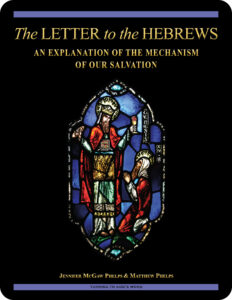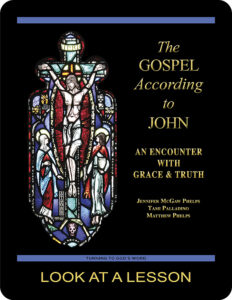 The Letter to the Hebrews:
The Letter to the Hebrews:
An Explanation of the Mechanism
of Our Salvation
Lesson 9 Enacted on Better Promises
the Letter to the Hebrews 8:1–13
Revised Standard Version Catholic Edition (RSVCE)*
New American Bible Revised Edition (NABRE)*
Catechism of the Catholic Church
ex libris (in our library)
Tami Palladino’s visual-meditation journal
cross references in the Letter to the Hebrews
next lesson: Mediator of the New Covenant
This material coordinates with Lesson 9 on pages 32–34 in he Letter to the Hebrews: An Explanation of the Mechanism of Our Salvation.
“In the days of his flesh, Jesus offered up prayers and supplications with loud cries and tears, to him who was able to save him from death, and he was heard for his godly fear. Although he was a Son, he learned obedience through what he suffered; and being made perfect he became the source of eternal salvation to all who obey him, being designated by God a high priest according to the order of Melchizedek.”—the Letter to the Hebrews 5:7–10
welcome to our in-depth study of the Letter to the Hebrews
We invite you to check out the sample first lesson and video from this 18-lesson  Turning to God’s Word Catholic Bible study. Our online study pages link to free
Turning to God’s Word Catholic Bible study. Our online study pages link to free  lesson videos and cross references in the biblical text, and include illustrations and prayers based on Scripture in each lesson. The Letter to the Hebrews: An Explanation of the Mechanism of Our Salvation has been granted an imprimatur. It currently being expanded; the content will be available in a new printed study at a later date. Please contact us if you’re interested in purchasing a digital copy of the existing study.
lesson videos and cross references in the biblical text, and include illustrations and prayers based on Scripture in each lesson. The Letter to the Hebrews: An Explanation of the Mechanism of Our Salvation has been granted an imprimatur. It currently being expanded; the content will be available in a new printed study at a later date. Please contact us if you’re interested in purchasing a digital copy of the existing study.
open with prayer
It’s always wise to begin any Bible study with prayer, whether reading the Scriptures alone or meeting with others in a discussion study group. You can pray using your own words or use one of the opening prayers on our website. We especially like the following:
Lord Jesus, you promised to send your Holy Spirit
to teach us all things.
As we read and study your word today,
allow it to touch our hearts and change our lives. Amen.
 better & better—let’s get right to the point
better & better—let’s get right to the point
In the seventh chapter in the Letter to the Hebrews, the author wrote about the introduction of a better hope. In the eighth chapter, the author now turns his attention to the better covenant mediated by Christ, a covenant enacted on better promises than the former covenant in place in the Old Testament. Don’t miss Tami Palladino’s illustrated reflections on the Scripture passages that form the basis of he Letter to the Hebrews: An Explanation of the Mechanism of Our Salvation. Click on the illustration (left) to enlarge it, and also check out Turning to God’s Word founder Tami’s visual-meditation journal to see all of her drawings and read her Scripture meditations. Tami’s reflections for this lesson, “Enacted on Better Promises,” are on pages 34 through 37 of her journal.
 every lesson has a free video (09:05)
every lesson has a free video (09:05)
Don’t forget—each lesson of The Letter to the Hebrews: An Explanation of the Mechanism of Our Salvation  has a related video. In these short presentations, Turning to God’s Word author Matthew Phelps reads the biblical text for the lesson and comments about it. You can watch the videos as part of your preparation for group discussion or to catch up if you have to miss a discussion. Some groups watch the videos together prior to their discussions. Because the videos are on YouTube, you can access them wherever and whenever it’s convenient—and they’re free. This study and its
has a related video. In these short presentations, Turning to God’s Word author Matthew Phelps reads the biblical text for the lesson and comments about it. You can watch the videos as part of your preparation for group discussion or to catch up if you have to miss a discussion. Some groups watch the videos together prior to their discussions. Because the videos are on YouTube, you can access them wherever and whenever it’s convenient—and they’re free. This study and its  videos are undergoing revision to incorporate additional material. The original content will be included in a different printed study. The original 18 lessons pertaining to the Letter to the Hebrews currently are available digitally.
videos are undergoing revision to incorporate additional material. The original content will be included in a different printed study. The original 18 lessons pertaining to the Letter to the Hebrews currently are available digitally.
WHAT DO YOU THINK about the true tent?
One of the most radical ideas advanced in the Letter to the Hebrews is that the earthly temple so treasured by God’s people is merely a copy of a much better and true temple in heaven.
? What is it that makes the heavenly sanctuary better? 
? What is it that makes it true?
? Why do you think the author of the Letter to the Hebrews stresses the true nature of the heavenly sanctuary?
? What are the better promises that Christians can count on as a result of a New Covenant governing the relationship agreement between God and humanity?
 the popes inspire us—Christ is new & eternal at the same time
the popes inspire us—Christ is new & eternal at the same time
“Newness of God” on page 34 in The Letter to the Hebrews: An Explanation of the Mechanism of Our Salvation is an excerpt from a general audience by Pope Benedict XVI. In it, the former pope teaches that not only is Jesus Christ the absolute newness of God, but at the same time Jesus Christ is present and active throughout the whole of history. Consider how this understanding might change your spiritual life and your relationship to Jesus.
at the heart of how salvation works
The idea of covenant is at the heart of how salvation works, and the author of the Letter to the Hebrews relies on his readers’ understanding of covenant to explain the mechanism of salvation. You can learn more about this Old Testament background by reading “Covenant” on page 33 in The Letter to the Hebrews: An Explanation of the Mechanism of Our Salvation.
 blasphemy—you could look it up in our archives
blasphemy—you could look it up in our archives
Although God announces that he’ll remember our sins no more, the Gospel According to Luke 12:10 brings up the unforgivable sin. To learn how this sin is related to blasphemy, read Lost in Translation, an online column in which Turning to God’s Word author Matthew Phelps helps readers connect with ideas expressed in the original languages of the Scriptures. New Lost in Translation entries are posted on Mondays, and past entries are archived on our website. Contact us if you’d like to receive Lost in Translation by email every week. During the Lenten season, you also can check out Jesus’ Passion: The Story of Redemptive Suffering, which is not available at other times of the year.
to receive Lost in Translation by email every week. During the Lenten season, you also can check out Jesus’ Passion: The Story of Redemptive Suffering, which is not available at other times of the year.
t he best Catholic commentary about Scripture
he best Catholic commentary about Scripture
To find out more about how Church teaching is supported by Scripture passages in The Letter to the Hebrews: An Explanation of the Mechanism of Our Salvation, check out the Index of Citations in the Catechism of the Catholic Church. Links (Revised Standard Version Catholic Edition [RSVCE*]) to the primary Scripture passages in the lesson and relevant paragraphs in the Catechism are provided here. Not every passage in the biblical text for this study is referenced in a Catechism paragraph, however.
the Letter to the Hebrews 8:2—paragraph 1070
the Letter to the Hebrews 8:6—paragraph 1070
the Letter to the Hebrews 8:8–10—paragraph 1965
to learn more, read more Scripture
If you’re having difficulty with a particular passage of Scripture, it can be helpful to read the relevant  cross references—but looking these up can take time. To make that easier, we’ve compiled the cross references from the Revised Standard Version Second Catholic Edition (RSV2CE)—the translation that we reprint in our study books. That list can be found at the top of every online study page, and it includes links to cross references in the primary biblical text for The Letter to the Hebrews: An Explanation of the Mechanism of Our Salvation.
cross references—but looking these up can take time. To make that easier, we’ve compiled the cross references from the Revised Standard Version Second Catholic Edition (RSV2CE)—the translation that we reprint in our study books. That list can be found at the top of every online study page, and it includes links to cross references in the primary biblical text for The Letter to the Hebrews: An Explanation of the Mechanism of Our Salvation.
don’t forget about our indexes & extra online material

 If you’re trying to locate information about a passage in Scripture, you can look it up in the index at the back of the study book. If you want to revisit a particular commentary, you can look that up by title in the topics index. If you want to learn more about another book of the Bible for which there’s a Turning to God’s Word study, you can read the online commentaries and watch any accompanying videos by going to the online study directories. Finally, if you have a question or would like to make a comment about any of our studies, you can use one of the “ask us your question” or “what do you think” buttons to email our authors.
If you’re trying to locate information about a passage in Scripture, you can look it up in the index at the back of the study book. If you want to revisit a particular commentary, you can look that up by title in the topics index. If you want to learn more about another book of the Bible for which there’s a Turning to God’s Word study, you can read the online commentaries and watch any accompanying videos by going to the online study directories. Finally, if you have a question or would like to make a comment about any of our studies, you can use one of the “ask us your question” or “what do you think” buttons to email our authors.
ex libris—Church documents & books about religious topics
You can find links to magisterial documents referred to in Turning to God’s Word Catholic Bible studies  at ex libris—magisterial documents. This page includes a listing of significant recent encyclicals as well as a number of historical Church documents. Recommended books related to Scripture study can be found at ex libris—main bookshelf.
at ex libris—magisterial documents. This page includes a listing of significant recent encyclicals as well as a number of historical Church documents. Recommended books related to Scripture study can be found at ex libris—main bookshelf.
wondering how to pronounce some of these words?
The following link is to a reading from the New International Version (NIV) Bible. To listen, click on the audio icon above the printed text. Although not taken from the translations used in our study materials, the NIV reading provides an audio guide to pronunciation of words in this lesson’s primary biblical text. An online version of the translation of the Bible used in Catholic liturgy in the United States as well as an audio guide for daily Mass readings for the current month can be found on the website of the United States Conference of Catholic Bishops (USCCB).
the Letter to the Hebrews 8:1–13 (NIV)
 close with Bible-based prayer related to this lesson
close with Bible-based prayer related to this lesson
Many of our Catholic study groups like to conclude their discussions with a prayer based on the scriptural focus of their lesson, and some participants include Scripture-specific prayer in their individual study. If you’re uncomfortable composing your own Bible-based prayers you can follow our four easy steps, or you can use the following prayer based on this lesson’s text from the Letter to the Hebrews.
God our Father, you sent your Son
to establish a new and better covenant with humanity.
Help us to honor your laws, which have been put
into our minds and written on our hearts.
We ask this in the name of Jesus Christ,
who as high priest is mediator of this better covenant. Amen.
Lesson 10 Mediator of the New Covenant, the Letter to the Hebrews 9:1–28
Lesson 8 A Better Hope Is Introduced, the Letter to the Hebrews 7:18–28
you also may like our study of the Gospel According to John
 The Gospel According to John: An Encounter with Grace & Truth, a 25-lesson Catholic Bible study with an imprimatur, examines the Fourth Gospel’s view of Jesus Christ as the Son of God, with special emphasis on the institution of the sacraments of the Church as the means by which Christians are purified and made holy. This recently revised study includes maps and additional commentary, and takes a closer look at the way in which Jesus relates to individual men and women. Click on the book’s cover to view a sample lesson.
The Gospel According to John: An Encounter with Grace & Truth, a 25-lesson Catholic Bible study with an imprimatur, examines the Fourth Gospel’s view of Jesus Christ as the Son of God, with special emphasis on the institution of the sacraments of the Church as the means by which Christians are purified and made holy. This recently revised study includes maps and additional commentary, and takes a closer look at the way in which Jesus relates to individual men and women. Click on the book’s cover to view a sample lesson.
start a Turning to God’s Word Bible study
Thank you for your interest in The Letter to the Hebrews: An Explanation of the Mechanism of Our Salvation.  Information about beginning a Turning to God’s Word Bible study can be found at start a Bible study. Tami, Matthew, and I are available to answer your questions and to offer support. Contact us if you’re interested in purchasing a digital version of this study, in starting another Turning to God study, or in having your study schedule listed with other TtGW study groups on our website. —Jennifer
Information about beginning a Turning to God’s Word Bible study can be found at start a Bible study. Tami, Matthew, and I are available to answer your questions and to offer support. Contact us if you’re interested in purchasing a digital version of this study, in starting another Turning to God study, or in having your study schedule listed with other TtGW study groups on our website. —Jennifer
*There are seven deuterocanonical books in the Old Testament—the Books of Tobit, Judith, Wisdom, Sirach, Baruch, and First and Second Maccabees, as well as some passages in the Books of Esther and Daniel. Protestants usually refer to these works as “apocryphal,” a word that means “outside the (Protestant) canon” because they’re excluded from most Protestant Bibles. The word “deuterocanonical” means “second canon”; Catholics use that word to refer to any section of the Catholic Old Testament for which there are no extant, or existing, Hebrew manuscripts. All of the deuterocanonical books appear in the Septuagint, the earliest remaining versions of which date to the 1st century B.C. This Greek translation of the Old Testament was in common use by Jews at the time of Jesus—but the same books aren’t found in existing Hebrew manuscripts, which aren’t as old as the oldest version of the Septuagint. Learn more by reading How Do Catholic & Protestant Bibles Differ?
Turning to God’s Word printed Bible studies use the 2006 Revised Standard Version Second Catholic Edition (RSV2CE) translation for all Scripture references except those to the Psalms, which are taken from The Abbey Psalms and Canticles, prepared by the Benedictine monks of Conception Abbey and published in 2020 by the United States Conference of Catholic Bishops (USCCB). All Scripture links for the online pages of The Letter to the Hebrews: An Explanation of the Mechanism of Our Salvation are to the 1966 Revised Standard Version Catholic Edition (RSVCE) translation. The New International Version (NIV) audio recordings follow the same chapter and verse numbering as the RSV Catholic translations, but the NIV translation doesn’t include the deuterocanonical books and passages.
The 1966 RSVCE uses archaic pronouns and verb forms such as “thee,” “thou,” “didst” in the Psalms and in direct quotations attributed to God. The 2006 RSV2CE replaces those with more accessible English. The few significant translation changes in the RSV2CE include rendering almah as “virgin” in the Book of Isaiah 7:14 and restoring the term “begotten” in the Gospel According to John 3:16.
Numbering varies for some passages in this Bible study. Turning to God’s Word studies (print and digital) follow the numbering in the Revised Standard Version Catholic translations (RSV2CE and RSVCE). Discrepancies in the New American Bible Revised Edition (NABRE) are noted in the Index of Scripture Citations in the study book and the online sample.
 You can learn more about the Psalms by viewing a sample lesson from the Turning to God’s Word Catholic Bible study Sing a New Psalm: Communicating with God Through the Prayers of the Church—Volume I: Lauds & Vespers. The second part of that study, Sing a New Psalm: Communicating with God Through the Prayers of the Church—Volume II: Vigils, Day Prayer & Compline, is scheduled for publication in 2025. Some verse numbers may vary in different translations of the Psalms.
You can learn more about the Psalms by viewing a sample lesson from the Turning to God’s Word Catholic Bible study Sing a New Psalm: Communicating with God Through the Prayers of the Church—Volume I: Lauds & Vespers. The second part of that study, Sing a New Psalm: Communicating with God Through the Prayers of the Church—Volume II: Vigils, Day Prayer & Compline, is scheduled for publication in 2025. Some verse numbers may vary in different translations of the Psalms.
